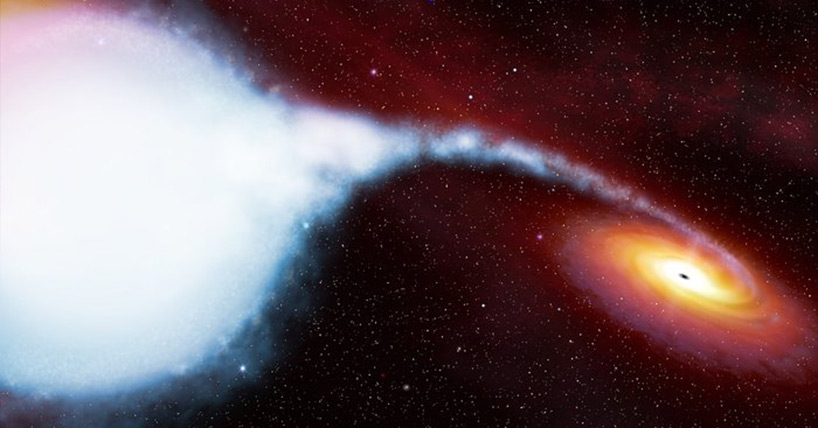Cygnus X-1
Research reveals details of extremely hot matter around black hole
Published on: 3 November 2022
Researchers’ recent observations of a stellar-mass black hole called Cygnus X-1 reveal new details about the configuration of extremely hot matter in the region immediately surrounding the black hole.
Matter is heated to millions of degrees as it is pulled toward a black hole. This hot matter glows in X-rays. The researchers used measurements of the polarization of these X-rays to test and refine models that describe how black holes swallow matter, becoming some of the most luminous sources of light — including X-rays — in the universe.
The new measurements from Cygnus X-1, published online by the journal Science on 3 November, represent the first observations of a mass-accreting black hole from the Imaging X-Ray Polarimetry Explorer (IXPE) mission, an international collaboration between NASA and the Italian Space Agency (ASI). Cygnus X-1 is one of the brightest X-ray sources in our galaxy, consisting of a 21 solar mass black hole in orbit with a 41 solar mass companion star.
“Previous observations only measured the brightness and colour of X-rays from the hot plasma spiraling towards black holes” said Dr Adam Ingram, a Lecturer and Royal Society University Research Fellow at Newcastle University. “IXPE also measures polarization, which is the direction that the electric field is oscillating in. Because this direction is governed by how the X-rays have scattered off material close to the black hole, it tells us about the configuration of the accreting plasma.”
No light, not even light from X-rays, can escape from inside the event horizon of a black hole. The X-rays detected with IXPE are emitted by the hot matter, or plasma, in a 2,000-km diameter region surrounding the 60-km diameter event horizon of the black hole.
Combining the IXPE data with concurrent observations from NASA’s NICER and NuSTAR X-ray observatories in May and June 2022 allowed the authors to constrain the geometry — i.e., shape and location — of the plasma.
The researchers found that the plasma extends perpendicular to a two-sided, pencil-shaped plasma outflow, or jet, imaged in earlier radio observations. The alignment of the direction of the X-ray polarization and the jet lends strong support to the hypothesis that the processes in the X-ray bright region close to the black hole play a crucial role in launching the jet.
The observations match models predicting that the corona of hot plasma either sandwiches the disk of matter spiraling toward the black hole or replaces the inner portion of that disk. The new polarization data rule out models in which the black hole’s corona is a narrow plasma column or cone along the jet axis.
The scientists noted that a better understanding of the geometry of the plasma around a black hole can reveal much about the inner workings of black holes and how they accrete mass.
“These new insights will improve our attempts to use the X-ray signal to measure the properties of black holes, and even test the strong gravity regime of Einstein’s theory of General Relativity. The main thing stopping us from doing this was the unknown shape of the corona, so these new observations have removed a major roadblock,” Ingram said.
Related to the Cygnus X-1 black hole specifically, “IXPE observations reveal that the accretion flow is seen more edge-on than previously thought,” explained co-author Michal Dovčiak at the Astronomical Institute of the Czech Academy of Sciences.
“This may be a signature of a misalignment of the equatorial plane of the black hole and the orbital plane of the binary,” or the paired duo of the black hole and its companion star, clarified co-author Alexandra Veledina from the University of Turku. “The system may have acquired that misalignment when the black hole progenitor star exploded.”
“The IXPE mission uses X-ray mirrors fabricated at NASA’s Marshall Space Flight Center and focal plane instrumentation provided by a collaboration of ASI, the National Institute for Astrophysics (INAF) and the National Institute for Nuclear Physics,” said co-author Fabio Muleri of INAF-IAPS. “Beyond Cygnus X-1, IXPE is being used to study a wide range of extreme X-ray sources, including mass accreting neutron stars, pulsars and pulsar wind nebulae, supernova remnants, our galactic center and active galactic nuclei. We’ve found a lot of surprises, and we’re having a lot of fun.
A second paper in the same issue of Science was led by Roberto Taverna at the University of Padova and describes the IXPE detection of highly polarized X-rays from the magnetar 4U 0142+61.
“We are thrilled to be part of this new wave of scientific discovery in astrophysics,” lead author Henric Krawczynski of Washington University in St Louis said.




